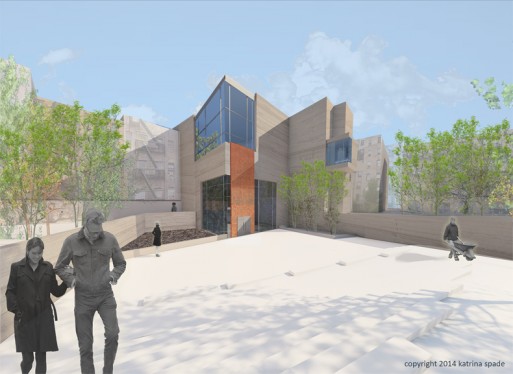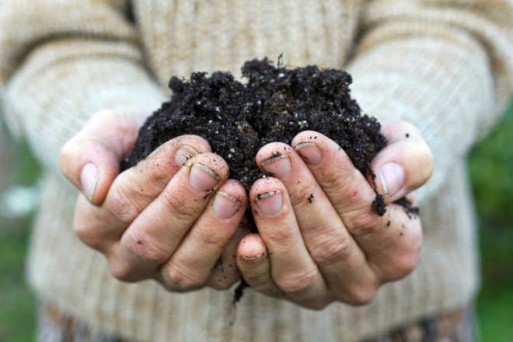
Credit: urbandeathproject.org
Growing up in a family whose idea of a vacation was constructing a chicken coop or putting shingles on a house, it’s no surprise that Katrina Spade chose architecture as a career. Her collaboration with Jamie Corn has produced playful and elegant designs in private homes as well as public spaces around Seattle, Washington, as well as on the East Coast. Influenced by her environmentally conscious parents, who grew their own food and composted, sustainability is at the heart of Katrina’s designs. Recognizing the lack of cemetery space in urban settings, Katrina envisioned a new approach for the disposal of the departed. Her Urban Death Project gives bodies a second life through the natural cycle of decomposition and return to the natural world without the use of toxic embalming chemicals, caskets or the burial plots.
Influenced by her environmentally conscious parents, who grew their own food and composted, sustainability is at the heart of Katrina’s designs.

Katrina Spade
(Credit: askcbi.org)
Both of Katrina’s parents practiced medicine, so death and dying were just a part of ordinary dinnertime conversation. Decay and decomposition were parts of a natural life cycle of a farm. However, Katrina didn’t think much about funerals until she was earning her Masters of Architecture at the University of Massachusetts, Amherst, “I realized that I was really and truly going to die someday.” She saw the current burial methods as “uninspired and unsustainable.” A compost heating system project, for which Katrina had received a grant from the Massachusetts Department of Agriculture was the impetus for the Urban Death Project, Katrina’s thesis and her current full-time endeavor.
Though such a burial system may sound unconventional and complex, the idea behind it is simple: it draws from the age-old methods of composting animal carcasses by farmers. The bodies are laid in and surrounded by aerated mixture of carbon material consisting of sawdust and wood chips inside a three-story cement “core.” Wood chips promote decomposition and absorb odors as a biological filter. After the breakdown transforms the materials inside the core into coarse compost, it is screened for foreign objects, such as gold teeth or titanium body parts, and then mixed. At the end of the cycle, a portion of the nutrient-rich compost is given to the family of the deceased to be used for tree planting or a memorial garden, while the rest becomes a part of the surrounding garden. Katrina believes that people are a part of the natural ecosystem, especially after death, since our decomposition is no different than what takes place naturally on the forest floor. “I find great solace in the fact that my physical body will be transformed – literally! – into soil, and then eventually into plant life.”
The project will provide the community with a meaningful and ecological option for their bodies when they die, as well as spaces for visiting with the natural world and remembering our dead.

Credit: ribuneindia.com
Katrina envisions such facilities in different urban neighborhoods. Though her first Urban Death Project model sports a clean, modern aspect, she specifies that the design should not be limited to just one aesthetic. “The idea is that each facility will be designed by a different architect and will be as unique as the community to which it belongs.” While the look of the buildings will vary to better fit the architectural style of any urban center, the core system will remain the same.
Besides the green and practical aspect of composting, the purpose of the Urban Death Project is to be a meaningful space for introspection, ritual and remembrance. “In some ways, decomposing a loved one is similar to having them cremated, in that families are able to create their own rituals from the material created.” Katrina hopes that the warmth of the core that results from the process inside, a play of darkness and light, sturdy construction and rooms designed to hold and protect the bereaved, will give comfort and support during the grieving process.
The families will also be able to honor their departed in a natural, tranquil garden setting. With the assistance of the Urban Death Project staff, the family will wash and wrap the body and subsequently carry it to the top of the core for the “laying in.” To bring more consciousness to the grieving process, Katrina stresses the importance of the family’s physical participation in the process by having contact with the deceased. Music, prayer and memorial service can also be incorporated into the ceremony. Katrina admits that in the final stages of composting, the remains will be mixed with those of other deceased members of the community, but even that can be viewed as a part of our collective existence. “I’m asking people to accept that we don’t all need our own space when we die.”
This project is designed so that the living can celebrate the passing of a loved one. But it’s also designed to embrace our part in a collective existence.
So far, says Katrina, the Urban Death Project has received overwhelmingly positive responses. Though not an expert in religion, she does not foresee friction from religious groups either. The first question that comes up, in response to her idea is, “What will you do about the smell?” Katrina is confident that the natural processes along with the help of the decomposition research station at Western Carolina University will perfect the dynamics of the core, addressing such concerns. In return, Katrina anticipates that “the project will provide the community with a meaningful and ecological option for their bodies when they die, as well as spaces for visiting with the natural world and remembering our dead.”

 Turn Me into Dirt and Flowers
Turn Me into Dirt and Flowers


 “In Case You Don’t Live Forever” by Ben Platt
“In Case You Don’t Live Forever” by Ben Platt
 Our Monthly Tip: Make an “In Case of Death” File to Ease Loved One’s Grief
Our Monthly Tip: Make an “In Case of Death” File to Ease Loved One’s Grief
 Passing of Beloved Comedian Births a New Comedy Festival
Passing of Beloved Comedian Births a New Comedy Festival














